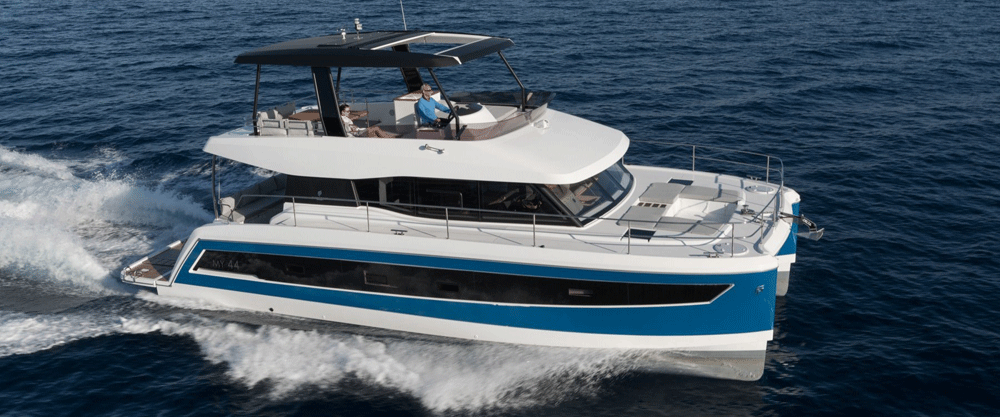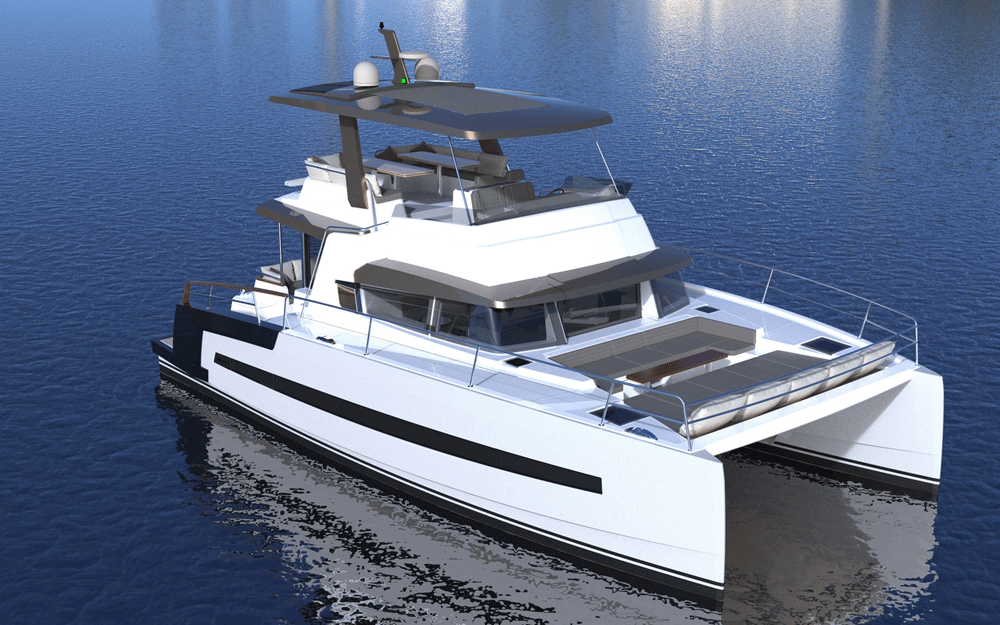Power Catamarans – Setting a New Standard in Boating Lifestyle by Peter Brady
I have been asked a number of times over the past 25 years while I have been designing and building power catamarans why I am such a strong believer in them and in particular the type that I call displaning and other designers like the late Malcolm Tennant called high speed displacement.
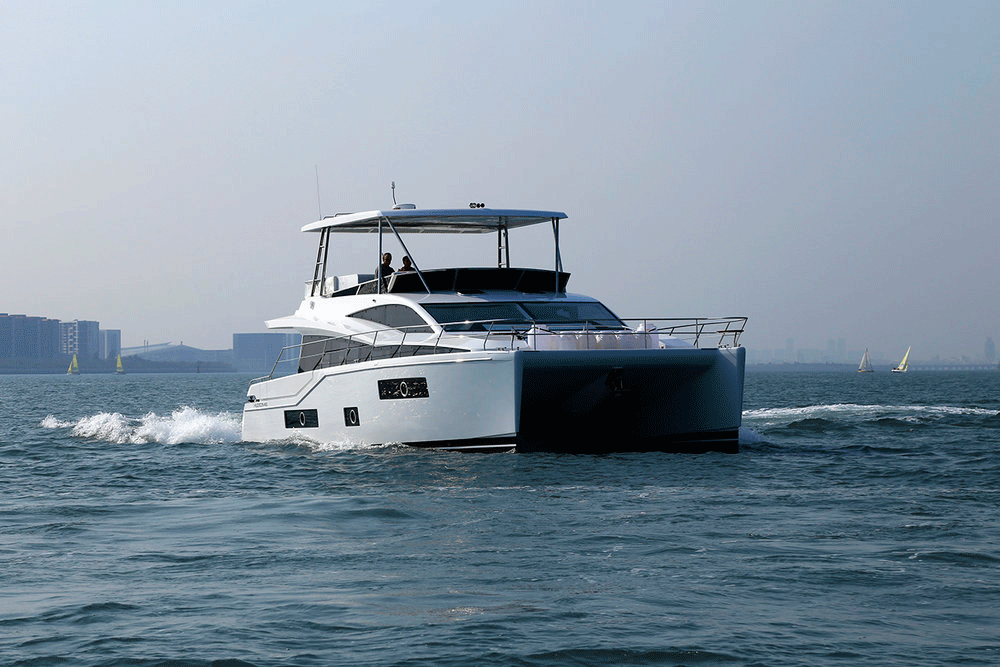
Why should I chose a power cat over a monohull?
Fuel economy a higher cruising speed and range stand out as the performance advantages of the displaning/high speed displacement power cats, however they are not the dominant reason when making the decision to purchase any type of power catamaran. Planning powercats are certainly popular and some Kiwi designers such as Roger Hill and Scott Robson are very active in this medium. However, it’s not all about hull design as lifestyle is still the reason most people chose power cats.
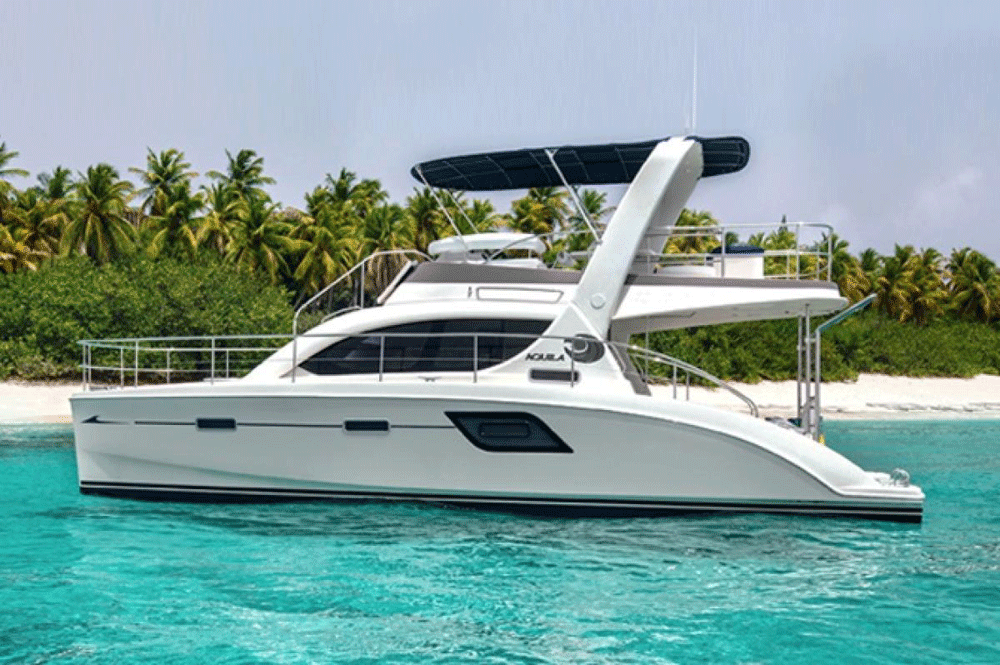
How do we know?
For the past 25 years that I have been designing and building power catamarans, my wife Lorma and I have spoken to or corresponded with thousands of people, mostly in Australia but also in New Zealand and around the world about power cats. In the course of these conversations or correspondence, we have had the opportunity to informally survey people who are considering power cats as to why they would choose them over the more conventional existing types of power boats and what features they want on them.
In the beginning our clients were considered on the fringe, or the leading edge, depending on your perspective and whilst we have predominantly been talking to them in regards to building a displaning power cat, most of what we have learnt from this research is relevant to all power boats.
From our informal survey let’s start with the reasons people stated for maybe not buying a power catamaran:
When we first began these conversations, the possibility of capsising a power catamaran was raised as it was still a very hot topic in regards to sailing multihulls, however these days it is never mentioned.
The next issue was the failure of overloaded planing cats to deliver on their promise of performance and whilst this is still relevant, it was and still is just as much of an issue with monohulls. The difficulty when dealing with this negative was that potential clients did not realise that there was another option in the form of the displaning hull, because there was no history or examples for the boating public or even designers at that stage to study.
In the early days there was also the issue of the power cat’s beam and the difficulty of finding marina berths and their cost. The power cats extra beam will still generally cost more for its length in a marina than a monohull, however the greater availability of berths since the GFC and the building of more multihull berths in newer marinas has made this less of an issue.
Lastly there was the claim that power catamarans were different and more expensive to build for their length, as well as the comment “I am not sure how the resale value will hold up”. Yes, power cats are more expensive to build for their length as they have up to a third more surface area and generally two engines, two sets of stern gear and rudders so it is not fair to make the comparison on length alone. As with all boats, resale value is based on a number of features, not just what type it is. Well designed and built boats that perform as intended will always hold a higher value than boats of a lesser standard, regardless of whether they are a monohull or catamaran, so this is more a question about quality rather than type and can be relatively easily explained. For example, we have vessels that were built over 10 years ago and are on the market for very close to what they were built for. So gradually, with more and more boats on the water, power cats have become more main stream losing the “different” tag and this is reflected in the number of European and Asian production boatbuilders entering the market.
What is it about power catamarans that makes the boating lifestyle on them different or better?
We asked both men and women what they wanted in a power boat that would allow them to enjoy their boating lifestyle to the fullest. Generally the women were talking to Lorma so were more open about what they did and didn’t like about boating and what their requirements were than if they had been talking to a man. Because she is a woman with thousands of sea miles behind her in power cats and offshore yacht racing including a Sydney to Hobart, she could answer their questions honestly and provide answers that they respected.
Our survey spread is not absolutely representative of all boaties, however it is a good cross section of experienced boaties looking for something different or to those wanting to own a power boat for the first time. It is also particularly representative of families and retired or soon to be retired couples and boaties who over the years have experienced offshore yacht racing in their younger days and were now looking to relax rather than compete.
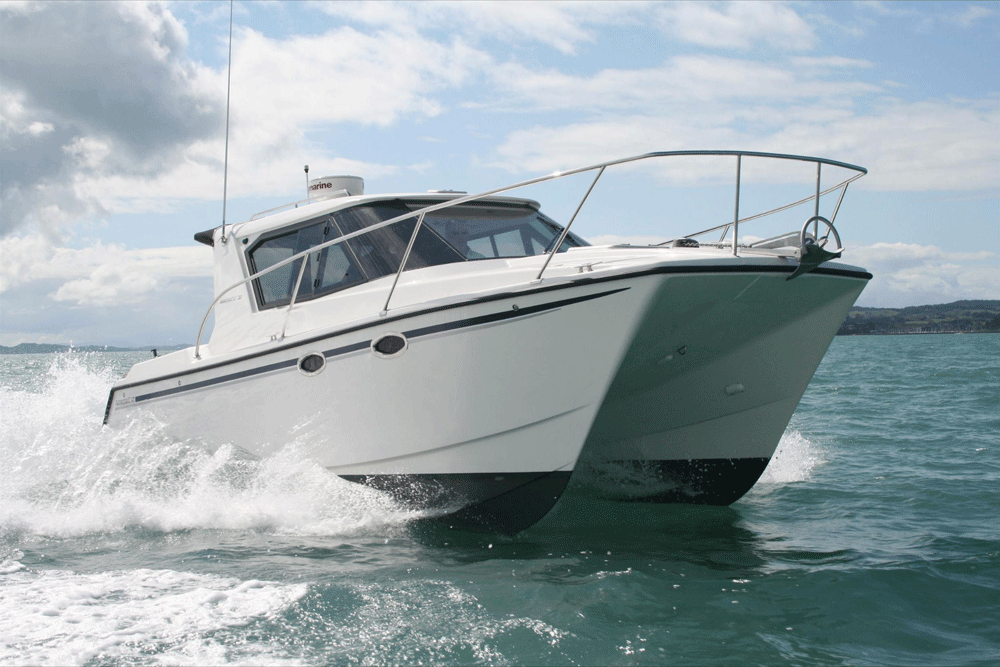
When women were asked what they wanted in a powerboat.
1: Stability
This is the dominant feature that makes power cats popular with women. When cruising or at anchor, they just want to relax. They don’t want to have put every item away in secure storage after they have used it or to be thrown out of bed with another boats wake when it passes their anchorage.
Power cat owners report a much lower incidence of seasickness and therefore a higher rate of enjoyable time on the water and as they are far less inclined to be macho, they don’t see throwing up as one of the rights of passage when going boating. As both sexes aged, they also commented that power cats were much easier on tired and damaged backs, hips and knees.

2: Space and the ability to use it in different ways.
The power catamaran is not constrained by rigging considerations like a sailing catamaran, so its beam in combination with the cabin shape provides a unique opportunity for designers to create vastly different layouts from either monohulls or sailing cats. Monohulls are bound, up to a certain length, by a tube or corridor arrangement that tends to create long, narrow lounge seats and tiny galleys with minimal bench space and storage.
In the past, galleys on both sailing cats and monohulls have often been stuck down amongst the sleeping arrangements almost as an afterthought, with very little visibility or ventilation. However this has changed as more women have become involved in boating and is very unusual these days. From 10m up, power catamarans can provide galley facilities equal to, or better than many small apartments with seating around a table suitable for all those on board and on power cats larger than 12m, separate dining and lounging arrangement are possible.
Even on 10m power cats it is possible to use domestic type furniture in the saloon. This allows owners to use their favourite chairs or to be able to change the furniture arrangement depending on how many are on board.
The two separate hulls of the power cat provide both visual and acoustically private sleeping arrangements and whilst smaller power catamarans are slightly restricted by the wing deck height and shape with their sleeping arrangement options, in vessels over 13.5 metres the possibilities are amazing.
In our latest launching of the Pathfinder Offshore 45 we have been able to arrange the owner’s stateroom across the front of the boat on a single level floor with a queen size bed and large en-suite, along with a queen double cabin and en-suite in one hull and a double bunk cabin with en-suite in the other.
In larger cats we have even fitted a spa bath and lounge plus a king sized bed in the owner’s stateroom. We believe it is this feeling of space along with the stability that makes power catamarans very attractive to women in particular and boaties in general.
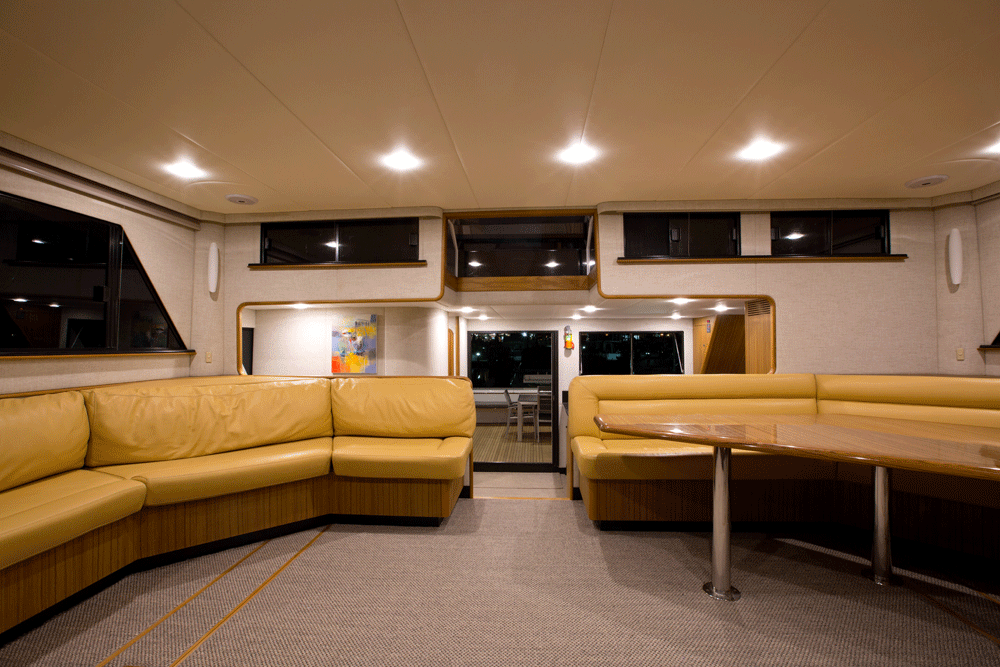
3: Visibility
Most boaties find good visibility and the light provided by it to be far more conducive to a relaxed lifestyle, therefore they are less likely to feel seasick if they can see what is going on around them. One of the main attractions for women to power cats is the possibility of having a more open plan arrangement, so the helm station, galley, dining area and saloon can be connected offering a more inclusive atmosphere and a feeling of being on the boat, not down in it.
4: Ventilation
Fresh air is very important when combating seasickness and keeping the interior cool. Ventilating the boat when locked up makes the boat far more pleasant to arrive at and starting a cruise in a dank, musty boat is not exactly a bonus when getting the family on board. Because power cat’s roll dramatically less that monohulls, their decks are normally fairly dry which can allow for some windows and portholes to be left partially ajar in more extreme conditions than usual, providing much better ventilation.
The trend towards power boats with all fixed windows that rely completely on air-conditioning was also a topic often discussed. Weekenders were not so bothered by having the genset running constantly (I’m not so sure their neighbours would be so impressed) but serious cruisers weren’t keen on this trend as a genset uses up valuable fuel, therefore diminishes range. A fresh, cool interior along with low maintenance and easily cleaned surfaces was also on most women’s want list as it allows all the family to enjoy the holiday or cruise – no one wants to spend their holiday scrubbing and cleaning.
Materials and colours don’t have to be stark, plastic or cheap, they just need to be carefully considered as to how they will work on a boat. This is not exclusive to power catamarans, however they are less hidebound by tradition and therefore modern low maintenance materials are more acceptable and used, although the trend toward sharp corners was not appreciated as most considered this just plain dangerous.
5: Storage
Most women requested as much storage as possible for clothes, personal effects, appliances, food etc. Men wanted storage for fishing rods, crab pots, barbecues, tools, engine spares, bait tanks, iceboxes and beverages. Unfortunately as with all boats, weight is a consideration and therefore storage has to be smart and tailored to the type of gear that is going to be used and carried on the boat and common sense must prevail when storing these items so as not to affect trim and therefore seaworthiness.
With their greater sensitivity to fore and aft trim the best way for designers and builders of power cats to ensure that everything is controlled, is to provide the space to store heavy items where they will have the least effect on the boats trim. Space is the power catamarans greatest asset, therefore it is in the designers and builders hands as to how they allocate it.
6: The ability to enjoy the comforts available at home
Old time boaties will scoff at this request, however times have changed and if families want to go cruising together, then concessions have to be made – after all, men want every fishing aid and water toy they can purchase along with the full electronics package. Toasters, bread makers, coffee machines, icemakers, dishwashers and washing machines are requested – all can be accommodated in power cats down to 12m in length, but it requires careful planning.
In most cases, the above deck layout of a power cat can be designed around a series of cubes which fits well with the shape of domestic appliances and the power catamarans stability allows most appliances to be used even when at sea, as they will not get tipped over or internally damaged.
7: Family friendly, safe and comfortable
Boats that are not family friendly make hard work for women when at sea. Trying to keep a close eye on children or inexperienced boaties is hard enough at the best of times, but if the design of the boat by its very nature forces people into small groups that cannot be easily supervised, then it is very difficult to enjoy a relaxed lifestyle. Conversely, a design that does not have room to easily move about and forces all on board in to one area is very testing on relationships.
A common observation from both men and women was that if a flybridge was fitted on a monohull, it was often too small to seat more than 3-4 people in comfort, and the motion on the flybridge was so severe that they never used them. The large comfortable flybridge or pilothouse on a power catamaran however provides a stable drive station with unmatched views for helming. It is a superb waterfront location for alfresco dining or cocktails with all round elevated views and catches the cool breeze when in the tropics, as does a large uncluttered back deck.
Both sexes also commented that ergonomics are important when relaxing and enjoying a boating lifestyle. Injuries caused by sharp corners or badly designed or located steps are not conducive to good times. Well designed power cats can provide wide clean decks with multiple, safe entertaining areas, a place for catching the sun and chatting on the foredeck, fishing or swimming from the cockpit during the day and entertaining in the cockpit, flybridge or saloon at night. These multiple entertainment areas are large enough to accommodate all the guests at one time, but also allow groups of adults, teenagers and children their own space, if required.
When men were asked what they wanted in a powerboat, they wanted two types of boat rolled into one.
Most wanted all the things that would encourage their wives, children, grandchildren and friends to cruise with them, but on top of this they then wanted the ability to be able to go fishing or diving with their mates. They raised the following issues such as:
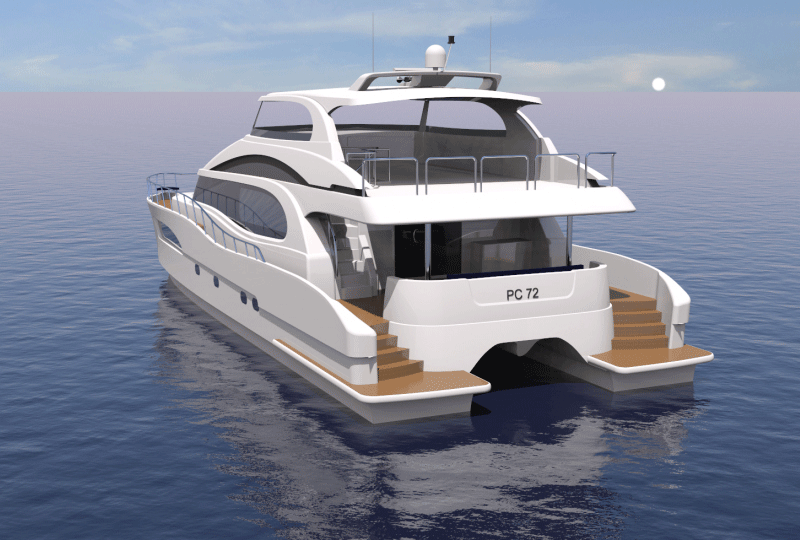
1: Space, privacy and variable sleeping arrangements
For family or groups of friends, both mixed and single sex to enjoy themselves on anything longer than a day trip, they must have space and privacy. Power cats are unmatched in this regard with different deck levels and a wider accommodation layout providing both visual and acoustic privacy.
Accommodation plans on power cats can offer both sleeping arrangements for singles or couples with their many level floor areas and can easily accommodate additional guests by utilising air beds or camp stretchers. A number of our clients have used sofa beds in the saloon as a backup sleeping option. They also have flybridge arrangements which provide extra berths if long-range cruising is planned as a day berth close to the helm is a huge bonus.
2: Power and speed
Whilst high speed was not the highest priority, a good cruise speed was a definite requirement for most men. This would allow them to get to fishing grounds quicker, to reach quieter and more private anchorages on day trips and to out-run worsening weather. Getting home quickly when kids and grandkids are tiring after a big day out on the water keeps the family happily boating together.
The power cats twin engines in separate hulls not only gives a high cruising speed from smaller power plants, but also provides unmatched safety with separate systems in each hull. Most of our clients cruise between 12-16 knots when offshore, but they find it reassuring to have the ability to go quicker should they need it. Our displaning power cat has the added advantage in this respect as it does not have an on-the-plane or off-the- plane attitude or trim, so owners can chose the correct speed for the conditions.
3: Range
Range provides options and faster passages. Constant fuel stops eat up time or could require the running of bars in less than ideal conditions. Often the weather has changed by the time refuelling has been completed, delaying voyages and ruining plans. High speed displacement power cats have created a unique ability to be able to combine a high cruising speed with long range and this ability adds a versatility that could only be dreamed of 20 years ago, although this is less of an issue in New Zealand with its shorter coastline than it is in Australia.
4: Fuel efficiency and therefore economy
Fuel efficiency means smaller engines and running gear which not only means a lower build cost and reduced service costs in the future, but with fuel prices again on the rise, economy also means the family can afford to use the boat more often and go further for their dollar.
So what is the ideal boating lifestyle and why does the power catamaran come closer to providing it than a monohull?
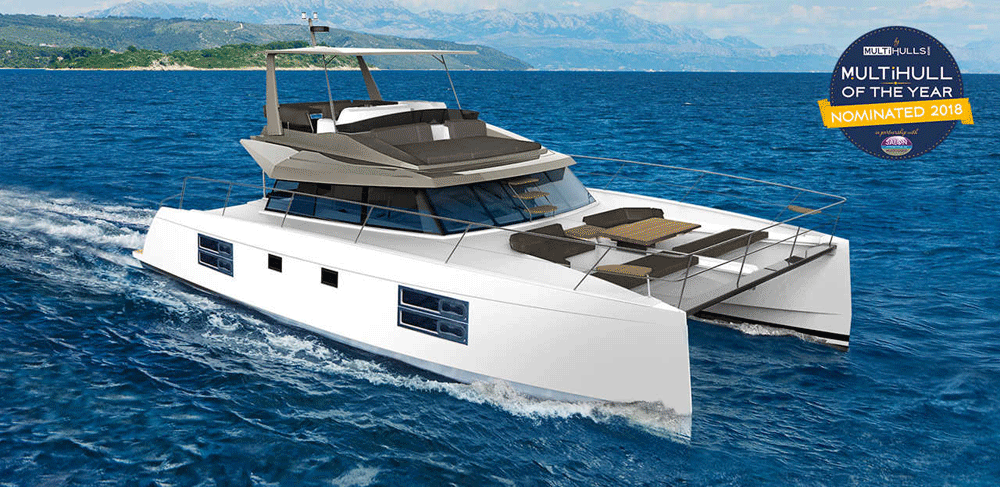
It is slightly different for different people, however there are some very common threads running through it. Women see a powerboat as an alternative to the beachfront holiday home. Yes, it may not have as much room and sometimes it can get a little uncomfortable, however this is balanced by the fact that they can have a different view every day and if they don’t like the neighbours, they can move. A boat will also provide their family and friends with unique opportunities like whale watching, diving and fishing without having to deal with tourism boat schedules or crowds.
Men see power boats as a family beach front home, a shed at the bottom of the garden to escape the pressures of life, a fishing shack, a dive platform, a chance to pit themselves against nature, and an electronic- mechanical toy to play with.
Families, couples or friends that regularly enjoy a boating lifestyle together form unique bonds, and retiring couples often start a new life together with different challenges such as navigation and meeting new friends. Many retired or semi-retired people just get to relax, read a book, visit places they have never been to and catch up with friends in beautiful anchorages.
Grandparents and parents get to hand down their nautical knowledge and life skills to the next generation and there is nothing like an invitation to stay on a comfortable boat in an exotic location to bring friends or family back together again.
Beautiful surroundings, great company, good food, new experiences and no pressure – that’s the ideal boating lifestyle. The power catamarans stability, space, pace and range provides the visibility, privacy and facilities of a waterfront apartment combined with the boating experience. This in turn makes families and in particular new converts to boating, feel more familiar with their surroundings and therefore relaxed. If everyone on board is relaxed, they will enjoy themselves and that’s what makes power cats something special.
